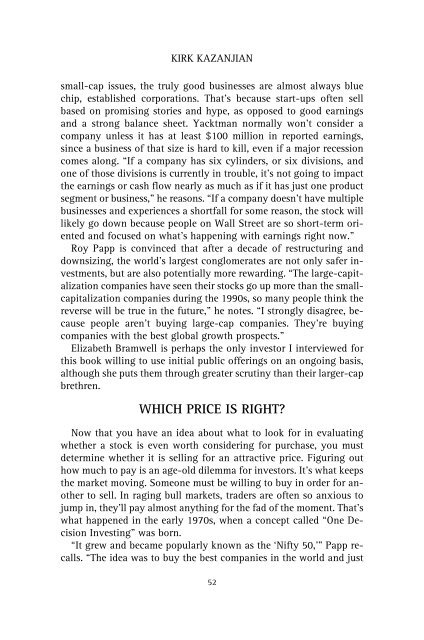You also want an ePaper? Increase the reach of your titles
YUMPU automatically turns print PDFs into web optimized ePapers that Google loves.
KIRK KAZANJIAN<br />
small-cap issues, the truly good businesses are almost always blue<br />
chip, established corporations. That’s because start-ups often sell<br />
based on promising stories and hype, as opposed to good earnings<br />
and a strong balance sheet. Yacktman normally won’t consider a<br />
<strong>com</strong>pany unless it has at least $100 million in reported earnings,<br />
since a business of that size is hard to kill, even if a major recession<br />
<strong>com</strong>es along. “If a <strong>com</strong>pany has six cylinders, or six divisions, and<br />
one of those divisions is currently in trouble, it’s not going to impact<br />
the earnings or cash flow nearly as much as if it has just one product<br />
segment or business,” he reasons. “If a <strong>com</strong>pany doesn’t have multiple<br />
businesses and experiences a shortfall for some reason, the stock will<br />
likely go down because people on Wall Street are so short-term oriented<br />
and focused on what’s happening with earnings right now.”<br />
Roy Papp is convinced that after a decade of restructuring and<br />
downsizing, the world’s largest conglomerates are not only safer investments,<br />
but are also potentially more rewarding. “The large-capitalization<br />
<strong>com</strong>panies have seen their stocks go up more than the smallcapitalization<br />
<strong>com</strong>panies during the 1990s, so many people think the<br />
reverse will be true in the future,” he notes. “I strongly disagree, because<br />
people aren’t buying large-cap <strong>com</strong>panies. They’re buying<br />
<strong>com</strong>panies with the best global growth prospects.”<br />
Elizabeth Bramwell is perhaps the only investor I interviewed for<br />
this book willing to use initial public offerings on an ongoing basis,<br />
although she puts them through greater scrutiny than their larger-cap<br />
brethren.<br />
WHICH PRICE IS RIGHT?<br />
Now that you have an idea about what to look for in evaluating<br />
whether a stock is even worth considering for purchase, you must<br />
determine whether it is selling for an attractive price. Figuring out<br />
how much to pay is an age-old dilemma for investors. It’s what keeps<br />
the market moving. Someone must be willing to buy in order for another<br />
to sell. In raging bull markets, traders are often so anxious to<br />
jump in, they’ll pay almost anything for the fad of the moment. That’s<br />
what happened in the early 1970s, when a concept called “One Decision<br />
Investing” was born.<br />
“It grew and became popularly known as the ‘Nifty 50,’” Papp recalls.<br />
“The idea was to buy the best <strong>com</strong>panies in the world and just<br />
52










